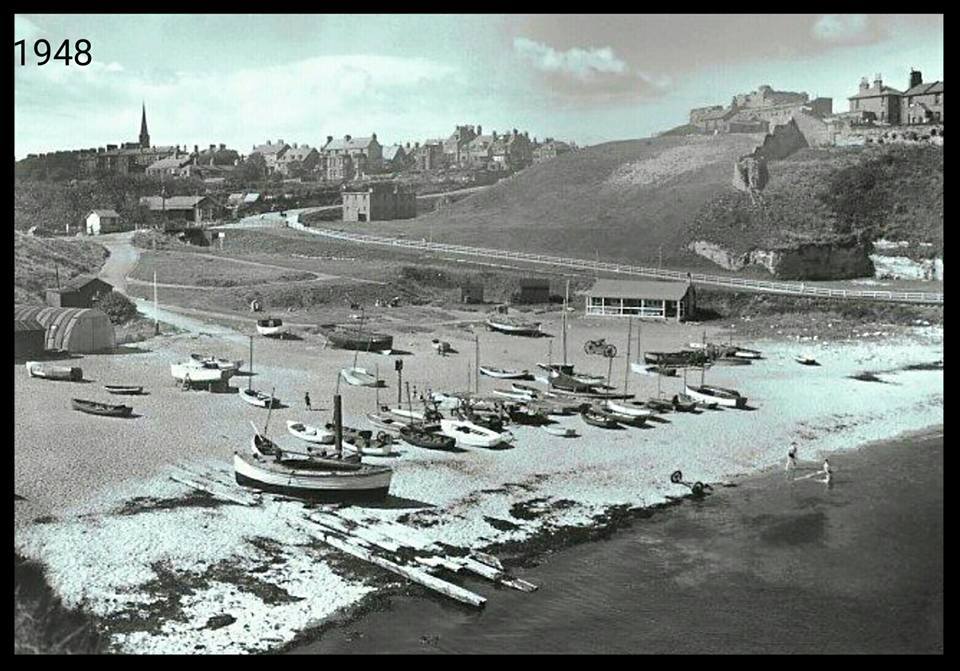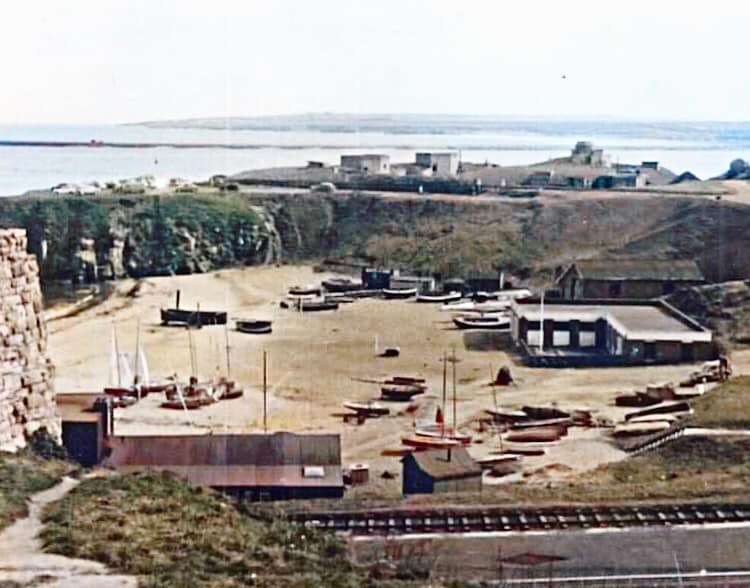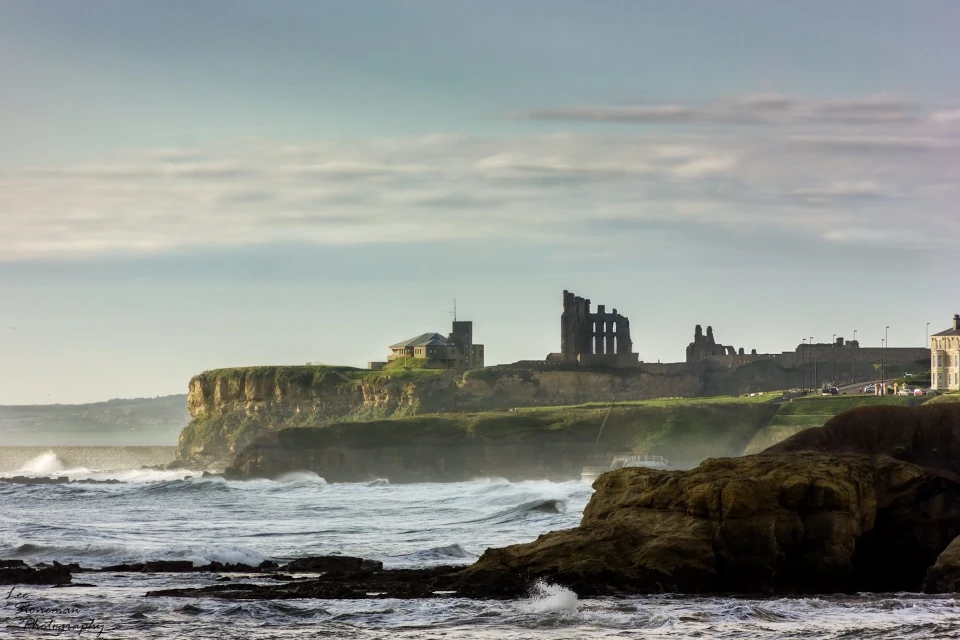Boats I Can Remember
By Dalton Linkleter (b. 1928)

“Orcadian” built by William Dalton Linkleter in 1908. She was a 16 foot 8 long clinker with a radiused [hull/stern?] and a cleverly artistic curved rake and transom. Orcadian had a rather veed [sleek?] section which made her a bit tender but very clean lines with a modern dinghy run. When I knew her she had end tanks and narrow side decks. She was a mystery boat apparently copied frequently by other members of the Linky family but never capturing the electric performance she had in the hands of my father or young Jimmy Linkleter. Typical of all the boats of that type she never was properly rigged. Balanced lug main, short mast bowsprit and small jib, but so elegant

“Linga-Longa” origin unknown, a basic 14 foot clinker built fishing boat, beamy with a transom stern and straight blunt stem. Rigged with a small dark tan lug sail and tiny jib. Sailed by Ross Linkleter, an enthusiastic fisherman who sailed the boat in the stern while his crew usually two small men sat on the bottom, amidships. Linga Longa was painted a dark back yard door green. She was always last by the end of the first leg and would wander off to a favourite fishing spot as soon as the leading boat overtook her. But Ross was always there at the start and did a great service ferrying people out to boats on the Haven moorings.
“Platypus” our boat, 16 foot clinker with a transom stern and short fore deck, she had what father called a tanker section, with very high vertical sides. She had a red mainsail pulled up to a “gunter” shape by means of an extra rope at the mast end of the gaff, which made the sail a rather nice shape. She had a big homemade jib that also set well. When father sailed her she always ended up with 5 or 6 boatless club members, so her race performance suffered. When “Feather” returned to the club father took over the sail training of the younger Aitcheson’s and we captured “Platypus”, sailing her with youthful exuberance and a maximum crew of three young men. Under these conditions sailed upright she was a fast as any of the rest of the fleet.
“Falcon” an old pre-war Northumberland One design, double diagonal carvel 16 feet long, quite beamy and with rather portly rounded sections. Fore deck and side decks, with a transom stern and a rather large sail area they were originally designed as a safe northeast coast club racing boat, they had been numbered and registered and had a fleet of about 12 boats all named after birds. Not the quickest of sailing shapes but sailed comfortably by Arthur Sutherland and “Tosh” Townsend and friends.
“Seahawk” a bit like a R.Y.N.C. One design but clinker built from some other part of the country, sailed by Fred Shaw and brother but without sparkling enthusiasm.
“Tomajico” Tom Crawshaw had this boat built by committee by one of the Storeys of Cullercoats, 16 feet long with a rather nasty racing dinghy vertical stem and supposedly a good run of planking aft, influenced by the talk of all the National sailors who went to inspect the progress of building .. she was always going to sail rings round Platypus and Orcadian, but never really performed to anywhere like expectations. Sailed by any sailor that Tom could persuade to do the driving. Famous because of its capsizing at the moorings during the “line squall”.
“Skippy” built by Eric Linkleter for young Dalton, but turned out to be a 12 foot long clinker built half barrel. Too rounded in the bottom and slightly lopsided, also heavily built for hauling up onto the Haven, she was supposed to “show the way” to Robin Stevenson’s Witch, when it first came to Tynemouth, but was sadly outclassed both in shape and in sails. Frequently sailed by “Slim” Limbrick until he capsized in the “line squall” and couldn’t right her. In fact he and “Dodger” Wynne almost lost their lives with the boat rolling over and over as they tried to pull her upright.
“Bustus” an old 12 foot National which we discovered later was one of the few that the designer Uffa Fox had actually built. She was sailed as a handicap boat by Andy Wallace, but was rather poorly rigged and produced no outstanding performances. Always classed as a bit of a dicey machine in those days of simple handicap boats.
“Feather” was built by father in 1936/37 double chine carvel, typical Linky rounded stem, with fore decks and side decks, but on instruction a rather large wide transom arranged to carry a large outboard motor left over from Sir Walters days of speedboat racing. Another badly rigged under canvassed boat still with a dagger plate of galvanised steel. “Feather” was not a good name for her as she was rather heavy.
“Nannette” another Linky boat this time built by Colin Linkleter. She was about 15 feet long with a nice tumbled in top plank, a pretty shear and the Linky rounded stem. Alan Linkleter who sailed her most, said she was tender initially but would stay at that angle no matter what blew. We had many a neck and neck race in Platypus, Alan always said she was a much kindlier boat that Orcadian, though I think not quite as fast.
“Jackie Forster” was a 16/18 foot coble beautifully made by Harrisons of Amble. She was black with a green underwater section and a white flash at the waterline, she had the coble shear and the forefoot of its family. because of the deep stem she was fitted with two dagger boards one in the normal place and one aft to counter the effect of it. Gaff rigged with rich tan balanced lug sail and small jib, she looked lovely and picturesque, unfortunately she took in water over her low waste if allowed to heel at all, when under sail. Too much of a handful for ordinary day sailors like Tom Slater her owner, she didn’t compete in club races, in fact she didn’t sail very much at all.
“Nimbus” Colin Linkleter produced another boat similar in most respects to all the Linky production but in this case she was 18 feet long, and a lovely powerful sailer. She was clinker with fore deck and side decks and a short bowsprit. Gaff rigged with a moderate jib, but again I think borrowed or reclaimed sails. Being big and roomy her handicap was always the number of passengers wanting to be her crew T.S.C. had a large collection of members that didn’t have a boat.
“Dishcloth” my canvas 11 foot boat hatched as a protest against fathers big numbers of crews and meant to be a single hander. A lot of people sailed her particularly Ken Middlemiss who raced regularly, but without out-performing anyone, because he always had “Fluffy” Robinson in tow as crew. “Fluffy” was a glamorous young lady and keen sailor and who because of the small cockpit always seemed to sit knee to knee with Ken.
“Sea Fever” was once owned by Tom Slater the son of a Tynemouth artist, she was a 23 foot double ended Norwegian fishing boat that had come across with refugees during the war and ended up on the Haven. Ken Middlemiss eventually owned her and he and his father put on a new deck and juggled with sail formation at one time being yawl rigged. She didn’t lend herself to going round triangular courses so Ken favoured “ocean” sailing.
“Valkyrie” this was another double ended style Norwegian style boat left over in a bad state from before the war. She was eventually taken over by Charles Boylan an interesting man who had spent the war driving M.T.B.s across the North Sea to Sweden, to collect ball-bearings for the war industry. “Valkyrie” though she arrived at the Haven nicely restored never really joined in much of the racing.
“Wren” a small Fry-built dinghy of rather petty lines owned by Norman Brown, was a clinker built boat with a tiny set of tan sails. Norman was really a fishing enthusiast so like Ross did more fishing than sailing.
“Joanna” belonging to a very large builder Jack Liddle and his wife was actually a Fairy moulded plywood tender for big yachts. She had a tiny lug sail and a little dagger board and a rounded fore end like the quarter of a ball. Jack sailed very keenly eventually becoming prime member of the club, introducing it to the Firefly of which he provided four in order to help encourage local sailors to partake in the Olympic trials.
“Eileen Mhor” Charles Shepherd produced the ‘EM’ in the very early days after the war, I don’t know where she came from but she was a typical little 14 foot clinker built dinghy with a fore deck, a straight stem and spirit, no side deck oars and rowlocks for an engine, and a small hinged centreboard. She was raced frequently with a hoard of small boys sat around on her bottom while Charles sat at the stern controlling things in a random manner.
“Frolic” was another Linky boat very similar to the rest.
“June” was another of the Linkleter productions, but something was the matter with her shear as she had a very low waste. Ken Allan her owner was always going to do great things with her, but I cannot remember her performing for long, perhaps she went off to Blyth.
“Anthea” Eric Linkleter built ‘Anthea’ again about 16 feet long in the similar style to the rest but unlike June, she had no shear. The revolutionary move on ‘Anthea’ was a Bermudan mast and modern sails. I remember her on the farthest out mooring, rocking violently in the swell, the movement accentuated by the long stick. She was owned by Rex Urwin and went off to Blyth, where he bought the first Folkboat, ‘Border Maid’ and ‘Anthea’ vanished.
“Zulu” A funny little Fry built cruising yacht about 16 feet long with a uniquely shaped stem and the most cleverly built radiused stern. Gaff rigged main and a small jib. Everyone in our family, in fact everyone in the pre-war club seemed to have sailed her on day cruises to Seaton Sluice and other exciting destinations.
“Pegasus” was an ex WD airborne lifeboat with a shape like a rather large sailing canoe. Mr Greesitt had converted the hull into a decked boat with side decks and a centre board.

Read ‘4th July 1948 — A Line Squall’



